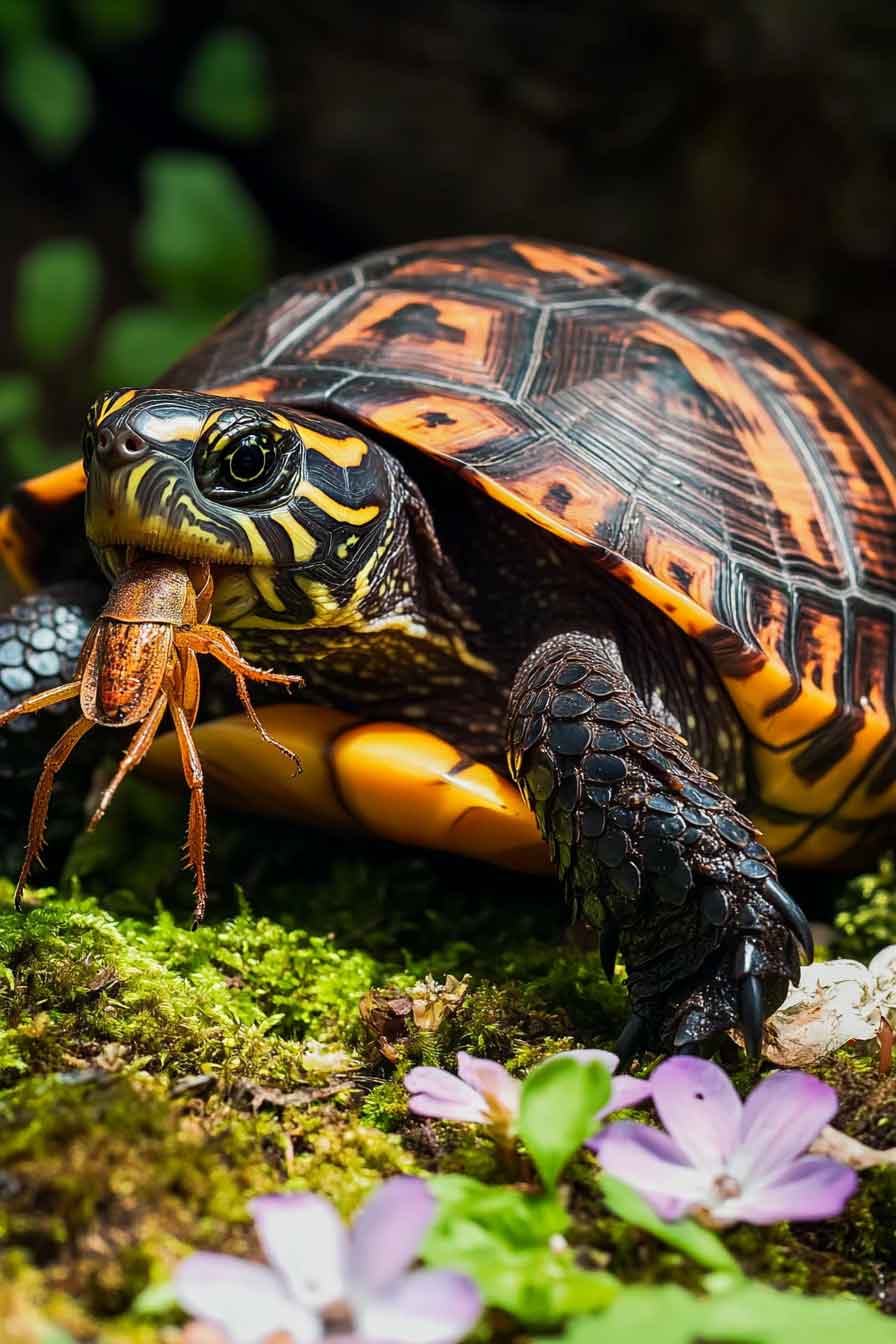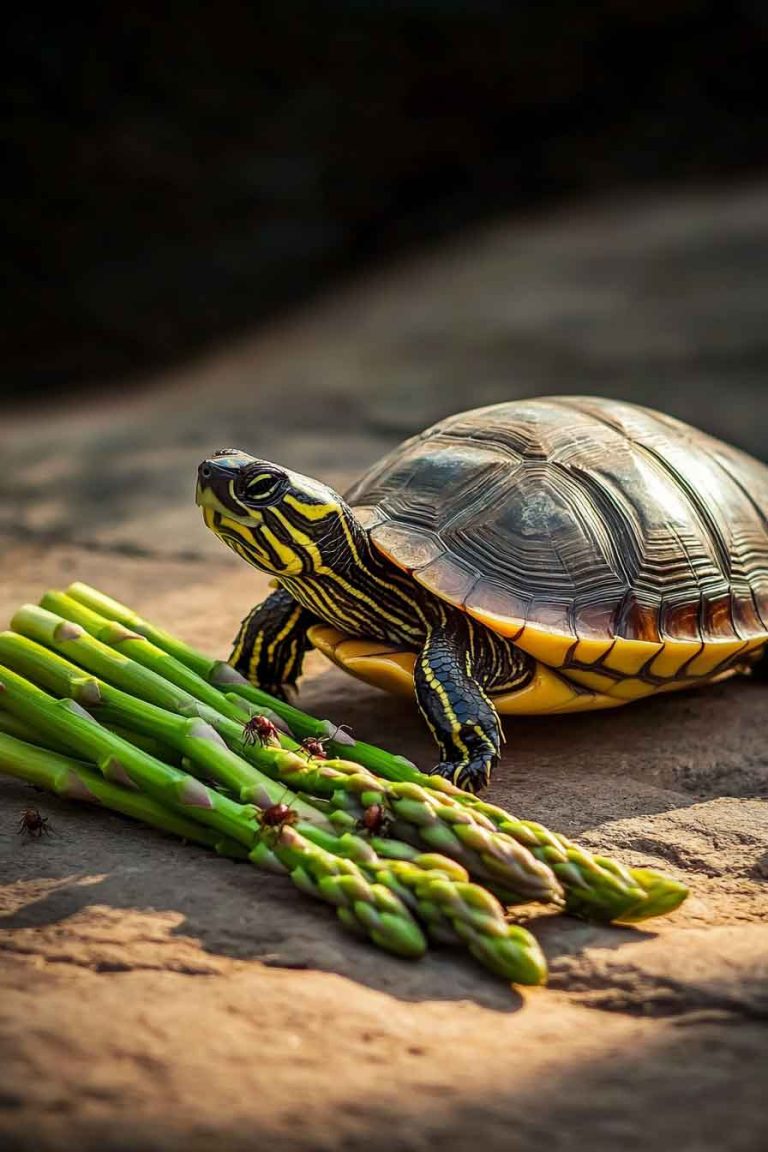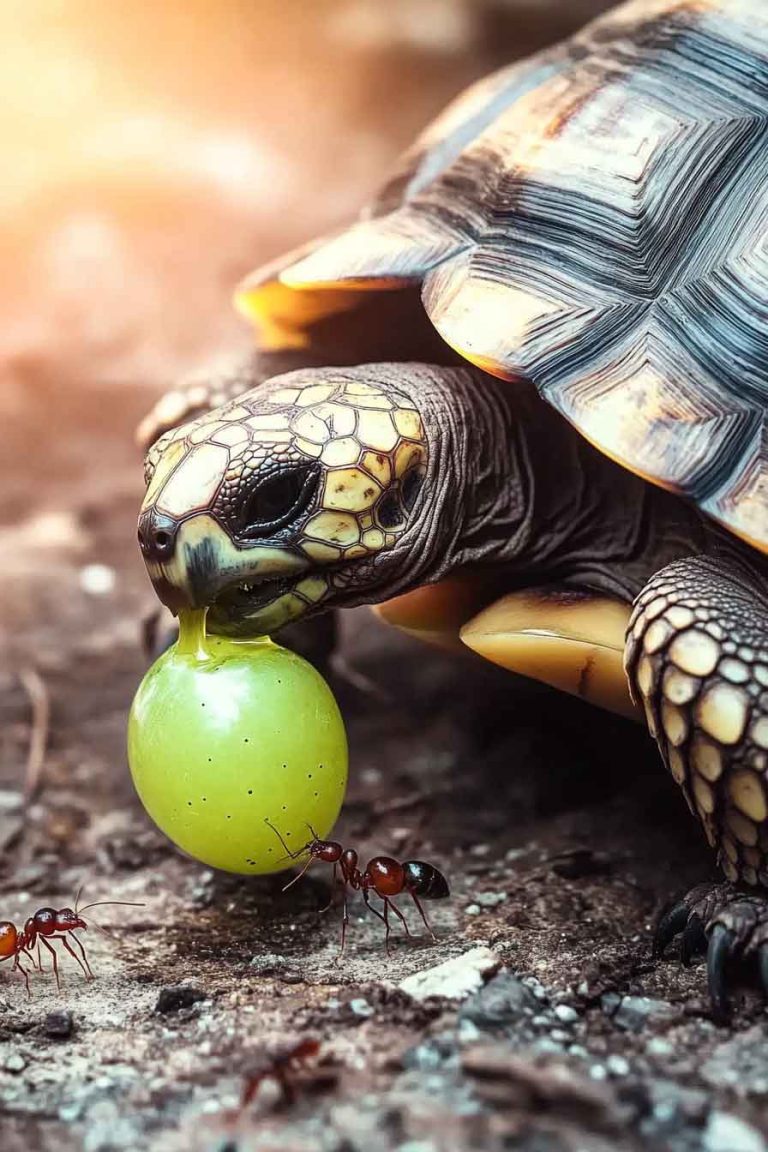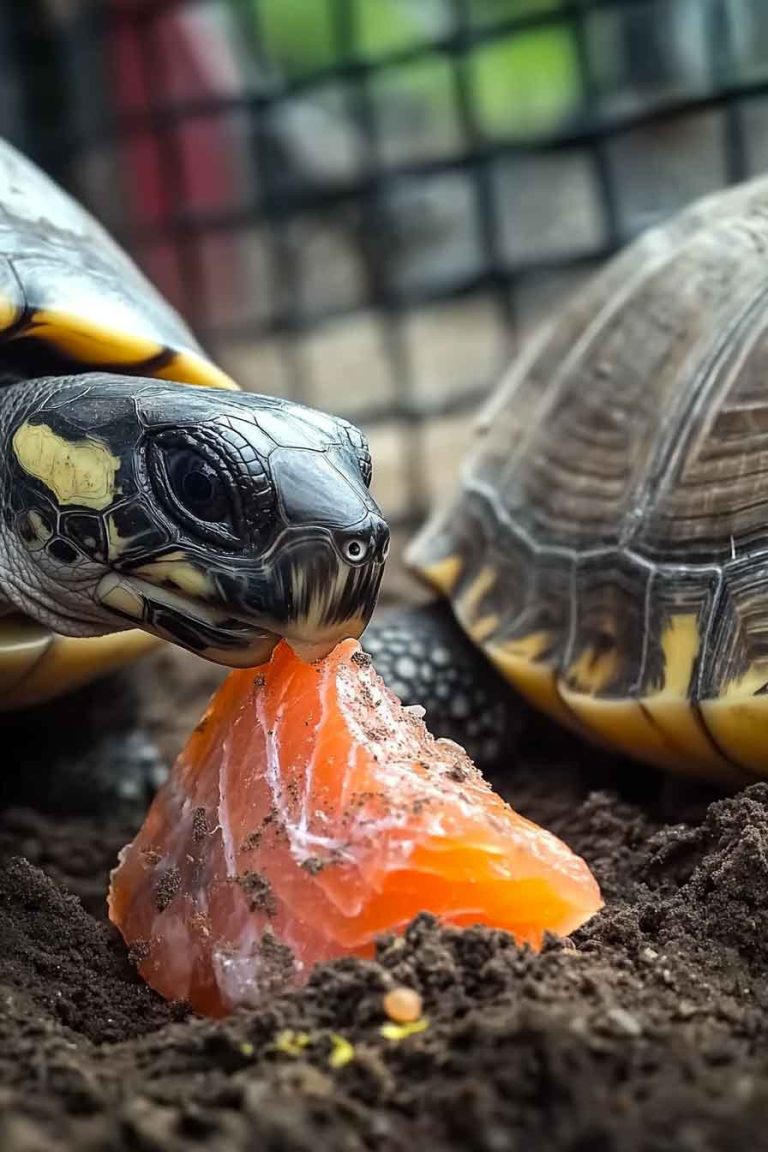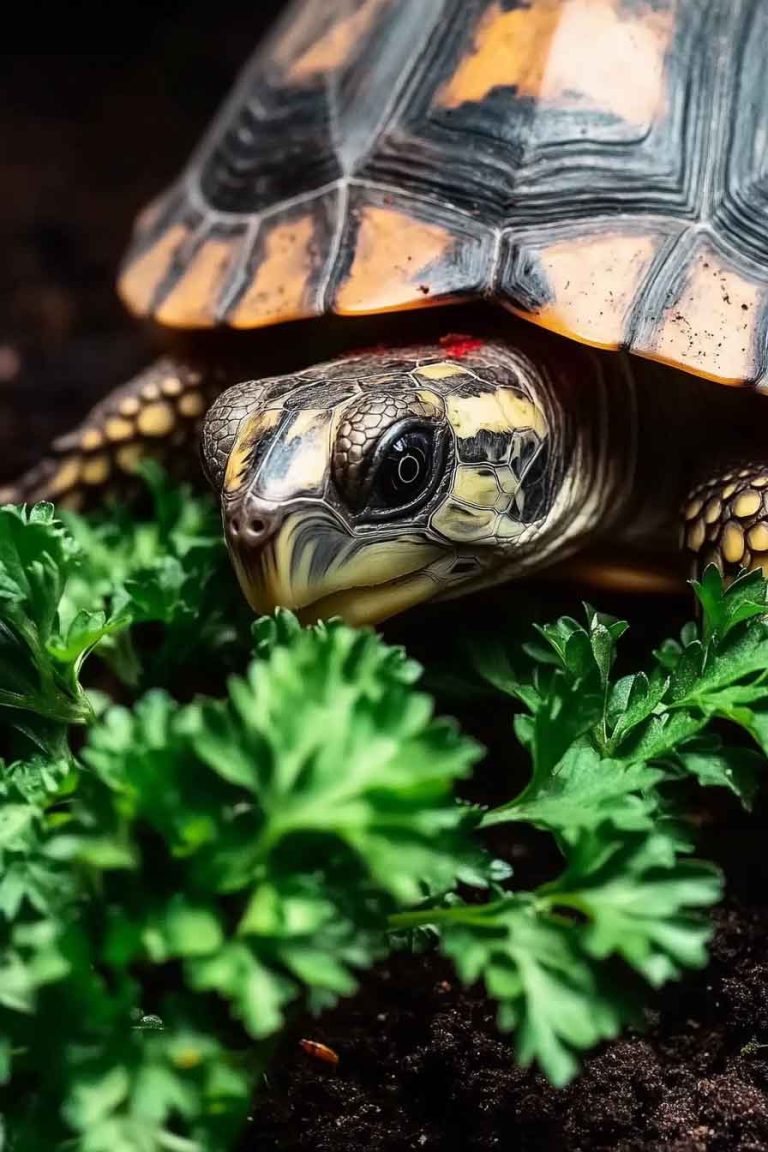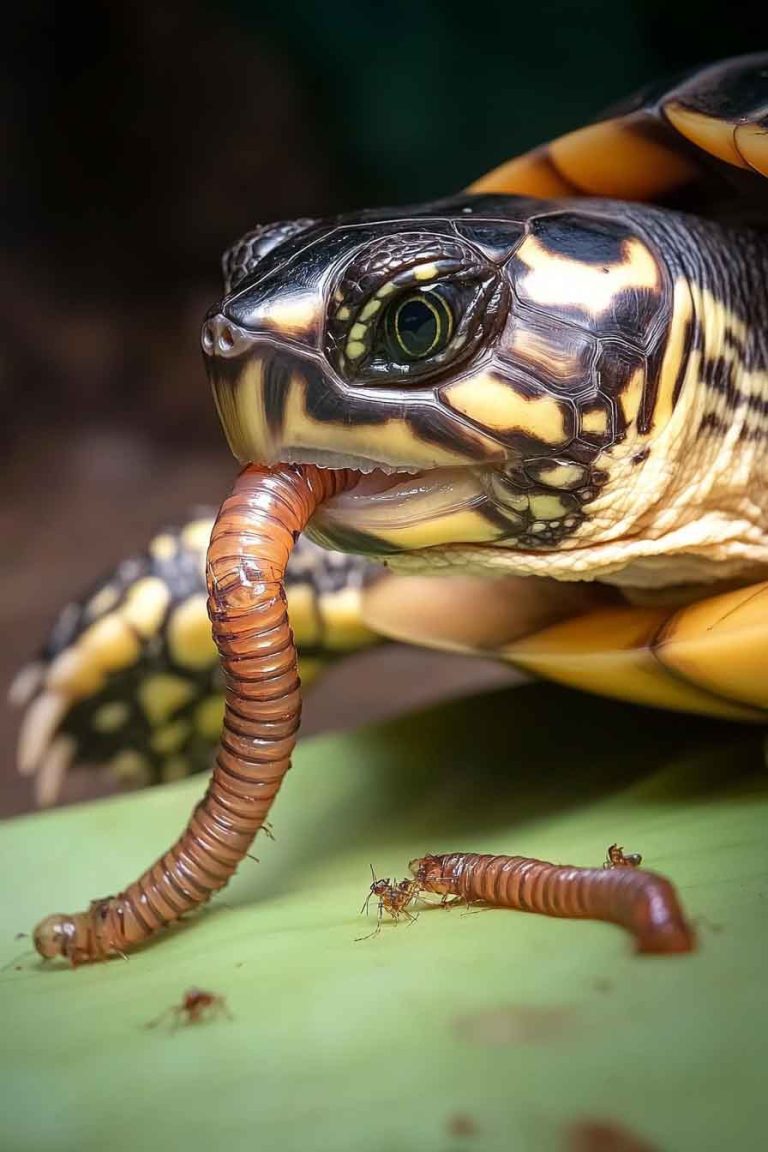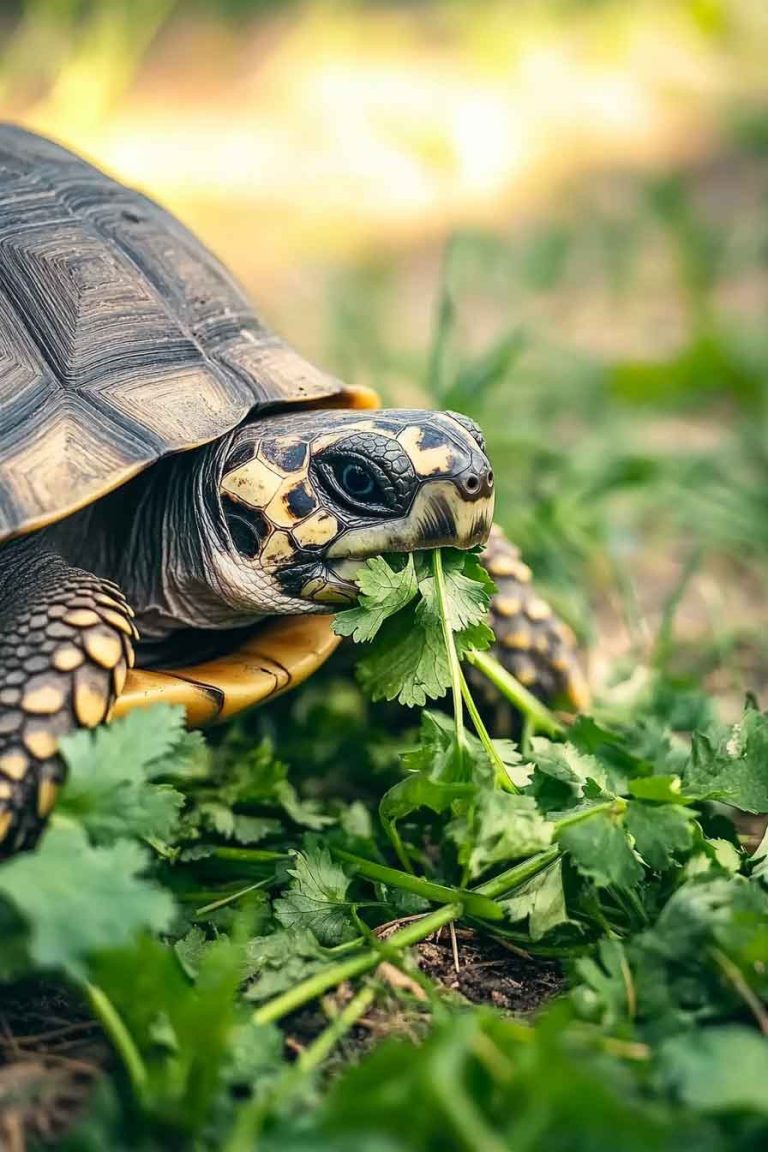Are Grasshoppers Safe for Turtles? What Every Owner Should Know
If you’re a turtle owner like me, you’ve probably watched your shelled friend explore their environment and wondered about expanding their diet. Maybe you’ve seen grasshoppers hopping around your yard and thought, “Would my turtle enjoy catching and eating one of these?” It’s a natural question that many of us turtle enthusiasts ask. So, can…
If you’re a turtle owner like me, you’ve probably watched your shelled friend explore their environment and wondered about expanding their diet. Maybe you’ve seen grasshoppers hopping around your yard and thought, “Would my turtle enjoy catching and eating one of these?” It’s a natural question that many of us turtle enthusiasts ask.
So, can turtles eat grasshoppers? The answer is yes – turtles can eat grasshoppers! In fact, grasshoppers are an excellent source of protein for many turtle species, especially omnivorous and carnivorous turtles. These insects provide essential nutrients that can benefit your turtle’s health when offered as part of a balanced diet.
In this comprehensive guide, I’ll walk you through everything you need to know about feeding grasshoppers to your turtle, including the nutritional benefits, potential risks, and best practices for safe feeding.
Can You Feed Grasshoppers To Your Pet Turtle?
The short answer is – absolutely yes! Unlike many foods that can be harmful to turtles, grasshoppers are actually a natural part of many turtle species’ diets in the wild. As someone who has been caring for turtles for years, I can tell you that most omnivorous and carnivorous turtle species will eagerly accept grasshoppers as a tasty treat.
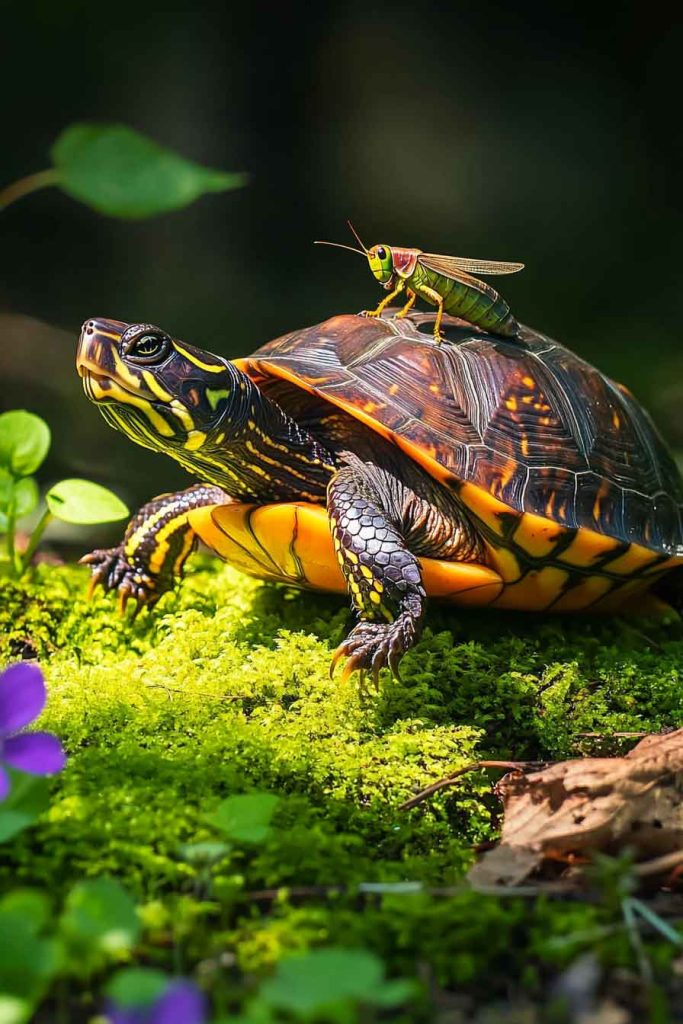
Turtles in their natural habitat regularly consume various insects, including grasshoppers, crickets, beetles, and other small creatures. This makes grasshoppers not only safe but also nutritionally appropriate for most turtle species.
Let’s examine the nutritional content of grasshoppers to understand why they’re such a great food option. Here’s what you’ll find in 100 grams of grasshoppers:
Protein: 20.6 g Fat: 6.1 g Carbohydrates: 3.9 g Fiber: 5.2 g Calcium: 35 mg Phosphorus: 185 mg Iron: 5 mg Zinc: 2.8 mg Vitamin B12: 5.2 mcg Folate: 45 mcg Magnesium: 72 mg
This nutritional profile shows us why grasshoppers are such a valuable food source for turtles. The high protein content supports healthy growth and shell development, while the essential minerals contribute to overall health.
However, I must point out that the calcium to phosphorus ratio is not ideal – grasshoppers contain more phosphorus than calcium. This means you’ll need to balance this by offering calcium-rich foods or supplements to maintain the proper 2:1 calcium to phosphorus ratio that turtles need.
Do Turtles Like Grasshoppers?
From my experience, most turtles absolutely love grasshoppers! I’ve watched my own turtles get excited when they spot a grasshopper, and the hunting behavior that follows is fascinating to observe. The movement of grasshoppers triggers their natural predatory instincts, making mealtime more engaging and mentally stimulating.
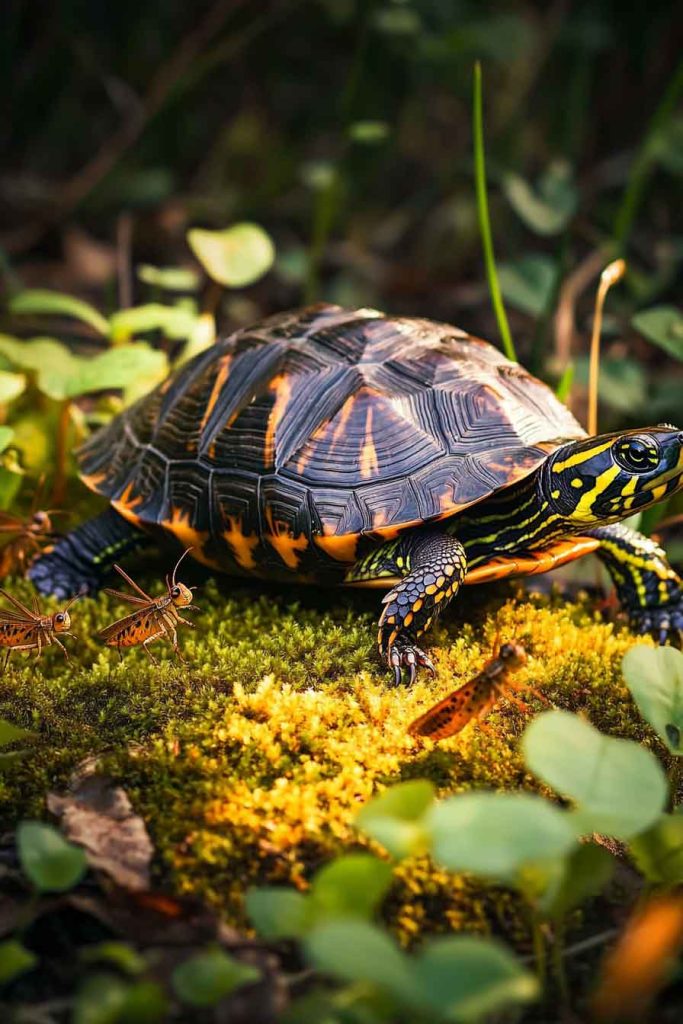
Different turtle species show varying levels of enthusiasm for grasshoppers:
- Box turtles are particularly fond of grasshoppers and will actively hunt them
- Red-eared sliders enjoy grasshoppers as a protein-rich supplement to their diet
- Painted turtles readily accept grasshoppers, especially younger individuals
- Snapping turtles will eagerly consume grasshoppers of any size
The key is introducing grasshoppers gradually and observing your turtle’s response.
Health Benefits of Turtles Eating Grasshoppers
Grasshoppers offer numerous health benefits for turtles when included as part of a balanced diet. Let me share the key advantages I’ve observed in my years of turtle care:
High-Quality Protein Source
Grasshoppers provide complete proteins containing all essential amino acids that turtles need for:
- Healthy shell development and maintenance
- Muscle growth and repair
- Proper organ function
- Strong immune system support
The protein in grasshoppers is easily digestible, making it an excellent choice for turtles of all ages.
Essential Vitamins and Minerals
Grasshoppers are packed with vital nutrients:
Vitamin B12: Crucial for nerve function and red blood cell formation Iron: Prevents anemia and supports oxygen transport Zinc: Boosts immune function and aids in wound healing Magnesium: Supports bone health and metabolic processes Folate: Important for cell division and DNA synthesis
Natural Foraging Behavior
Feeding live grasshoppers encourages natural hunting behaviors, which provides:
- Mental stimulation and enrichment
- Physical exercise
- Stress reduction through natural activity
- Enhanced quality of life
Digestive Health Support
The fiber content in grasshoppers aids in healthy digestion, while the natural chitin in their exoskeleton can help with digestive tract health.
Potential Risks and Considerations
While grasshoppers are generally safe and beneficial for turtles, there are some important considerations I always share with fellow turtle owners:
Calcium-Phosphorus Imbalance
As mentioned earlier, grasshoppers have more phosphorus than calcium. To address this:
- Dust grasshoppers with calcium powder before feeding
- Offer calcium-rich foods like leafy greens alongside grasshoppers
- Consider calcium supplements as recommended by your veterinarian
Pesticide Concerns
Never feed grasshoppers caught from areas that may have been treated with pesticides, herbicides, or other chemicals. These toxins can be deadly to turtles. Always:
- Source grasshoppers from reputable suppliers
- Avoid collecting grasshoppers from urban areas
- Choose organic or pesticide-free options when possible
Size Considerations
Ensure the grasshoppers are appropriate size for your turtle:
- Baby turtles need very small grasshoppers or grasshopper nymphs
- Adult turtles can handle full-sized grasshoppers
- Remove any uneaten portions after feeding to prevent spoilage
How Many Grasshoppers Should Turtles Eat?
The number of grasshoppers you should feed your turtle depends on several factors. Based on my experience, here are my recommendations:
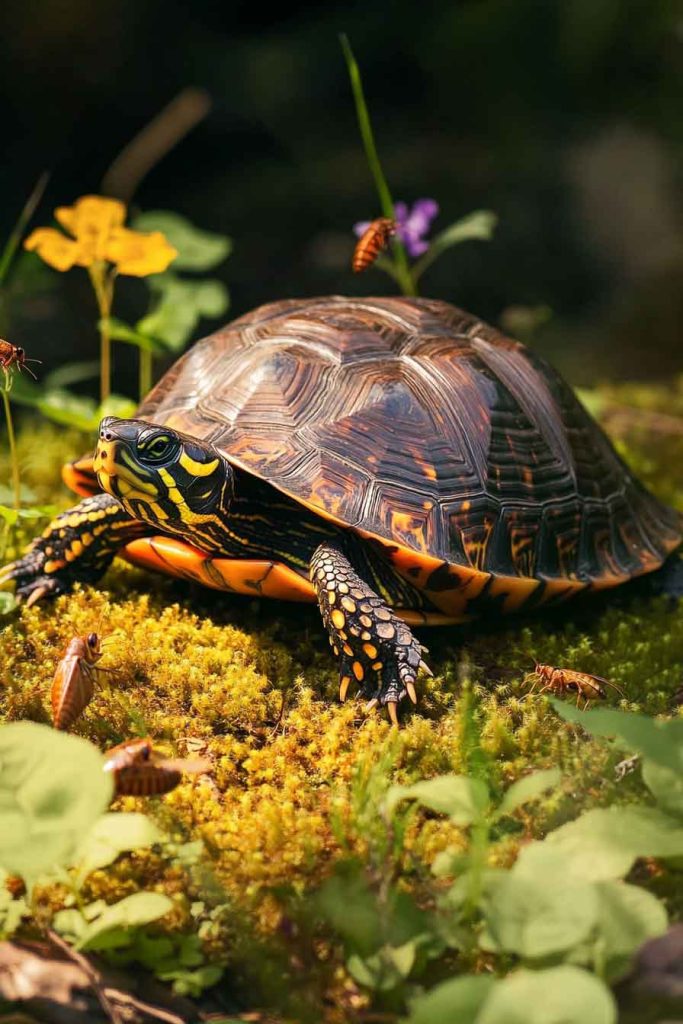
For Adult Turtles (4+ inches shell length):
- 2-4 medium grasshoppers per feeding session
- Offer 1-2 times per week as part of a varied diet
- Always combine with vegetables and other protein sources
For Juvenile Turtles (2-4 inches shell length):
- 1-2 small grasshoppers per feeding session
- Once per week maximum
- Focus primarily on commercial turtle pellets for balanced nutrition
For Baby Turtles (under 2 inches shell length):
- Very small grasshoppers or grasshopper pieces only
- No more than once per week
- Ensure pieces are smaller than the space between the turtle’s eyes
Remember, grasshoppers should never make up more than 25% of your turtle’s total protein intake. A varied diet is essential for optimal health.
Can You Feed Grasshoppers to Baby Turtles?
Yes, you can feed grasshoppers to baby turtles, but with important modifications. Baby turtles have different nutritional needs and physical limitations compared to adults.
Special Considerations for Baby Turtles:
Size Matters: Baby turtles can only handle very small grasshoppers or pieces of larger ones. I recommend cutting grasshoppers into appropriate sizes or sourcing grasshopper nymphs.
Frequency: Limit grasshopper feeding to once per week maximum. Baby turtles need consistent nutrition from high-quality commercial pellets designed for their age group.
Calcium Supplementation: Baby turtles are building their shells and bones rapidly, so calcium supplementation is even more critical when feeding grasshoppers.
Supervision: Always supervise baby turtles during feeding to ensure they can handle the food properly and aren’t choking.
Best Practices for Feeding Grasshoppers to Turtles
After years of feeding grasshoppers to various turtle species, I’ve developed a system that works well:
Sourcing Grasshoppers
- Commercial Sources: Purchase from reptile supply stores or online retailers
- Farm-Raised: Choose grasshoppers specifically raised as reptile food
- Wild Collection: Only if you’re certain the area is pesticide-free and legal to collect from
Preparation Steps
- Gut-Loading: If using live grasshoppers, feed them nutritious foods 24 hours before offering to your turtle
- Calcium Dusting: Lightly dust grasshoppers with calcium powder
- Size Check: Ensure grasshoppers are appropriate for your turtle’s size
- Fresh Feeding: Offer grasshoppers immediately after preparation
Feeding Method
- Offer grasshoppers in a shallow dish or feeding area
- Allow your turtle to hunt live grasshoppers for enrichment
- Remove any uneaten portions within 2-4 hours
- Observe your turtle’s eating behavior and adjust portions accordingly
Species-Specific Considerations
Different turtle species have varying dietary needs and preferences when it comes to grasshoppers:
Box Turtles
Box turtles are natural omnivores that readily accept grasshoppers. They particularly enjoy hunting live grasshoppers, which provides excellent mental stimulation. Offer 2-3 grasshoppers twice per week alongside fruits and vegetables.
Red-Eared Slider Turtles
Red-eared sliders benefit from grasshoppers as a protein source, especially juveniles and adults. However, older sliders tend to eat more vegetation, so adjust portions accordingly. Offer 2-4 grasshoppers once or twice per week.
Painted Turtles
Painted turtles, especially younger ones, eagerly consume grasshoppers. As they mature, they eat more plant matter, but grasshoppers remain a valuable protein source. Provide 1-3 grasshoppers weekly for juveniles, less frequently for adults.
Snapping Turtles
Snapping turtles are voracious predators that will readily consume grasshoppers of any size. Due to their large appetite and size, they can handle more grasshoppers than other species. Offer 4-6 grasshoppers per feeding session for adults.
Alternatives to Grasshoppers
If grasshoppers aren’t available or suitable for your turtle, consider these alternatives:
- Crickets: Similar nutritional profile and hunting behavior
- Mealworms: High protein but should be fed less frequently due to high fat content
- Dubia roaches: Excellent protein source with better calcium-phosphorus ratio
- Earthworms: Great for aquatic species, rich in protein and minerals
- Commercial insect pellets: Convenient option with balanced nutrition
Signs of Proper Nutrition
When feeding grasshoppers as part of a balanced diet, watch for these positive signs in your turtle:
- Steady, appropriate growth rate
- Strong, well-formed shell
- Active behavior and alertness
- Healthy appetite
- Clear eyes and clean skin
- Regular, normal bowel movements
When to Consult a Veterinarian
Contact a reptile veterinarian if you notice:
- Loss of appetite after introducing grasshoppers
- Unusual lethargy or behavioral changes
- Digestive upset or unusual bowel movements
- Shell deformities or softening
- Any signs of illness or distress
Video: Watching a Turtle Hunt Grasshoppers
There’s something truly mesmerizing about watching a turtle’s natural hunting instincts kick in when presented with a grasshopper. The focused attention, strategic positioning, and quick strike showcase behaviors that captive turtles rarely get to express with commercial foods.
[Note: Insert video of turtle catching and eating grasshopper here]
This natural foraging behavior not only provides nutrition but also essential mental and physical stimulation that contributes to your turtle’s overall well-being.
Frequently Asked Questions (FAQs)
Can Aquatic Turtles Eat Grasshoppers?
Yes, most aquatic turtle species can and will eat grasshoppers. However, they may prefer to take them into the water to consume them, which is perfectly natural behavior.
Are Dead Grasshoppers Safe for Turtles?
Fresh dead grasshoppers are safe, but avoid those that have been dead for extended periods or show signs of decay. Frozen grasshoppers from reptile suppliers are a safe alternative to live ones.
Can Grasshoppers Replace Commercial Turtle Food?
No, grasshoppers should supplement, not replace, commercial turtle food. Commercial foods are formulated to provide balanced nutrition that grasshoppers alone cannot provide.
How Do I Know if My Turtle is Allergic to Grasshoppers?
Turtle allergies to grasshoppers are extremely rare. However, watch for unusual symptoms like excessive scratching, swelling, or digestive upset after introducing grasshoppers.
Can I Feed My Turtle Grasshoppers from My Garden?
Only if you’re certain your garden hasn’t been treated with any chemicals and the area isn’t contaminated with pollutants. Farm-raised grasshoppers are always the safer option.
Should I Remove Grasshopper Legs Before Feeding?
This isn’t necessary for most turtles. The legs provide additional nutrition and fiber. However, very small turtles might benefit from having large legs removed to prevent choking.
Conclusion
Grasshoppers are an excellent addition to most turtles’ diets when offered properly and in moderation. They provide high-quality protein, essential nutrients, and mental stimulation that commercial foods simply cannot match. The key is understanding your specific turtle species’ needs, sourcing quality grasshoppers, and maintaining a balanced approach to feeding.
As a fellow turtle enthusiast, I encourage you to consider incorporating grasshoppers into your turtle’s diet if appropriate for their species. Start slowly, observe your turtle’s response, and always prioritize safety by sourcing from reputable suppliers.
Remember, the joy of keeping turtles comes not just from providing adequate care, but from enriching their lives with natural behaviors and varied nutrition. Grasshoppers offer both, making them a valuable addition to any turtle keeper’s feeding arsenal.
Your turtle’s health and happiness depend on the choices you make as their caretaker. By understanding the benefits and proper usage of foods like grasshoppers, you’re taking an important step toward providing the best possible care for your shelled companion.

